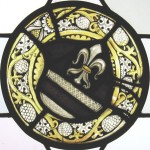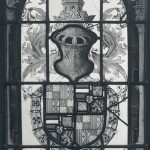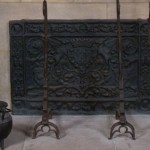 |
 |
 |
Above, from left to right: Heraldic Roundel (1980.214.4); Heraldic Panel with the Arms of the House of Hapsburg (37.147.2); Fireback (46.195); The Metropolitan Museum of Art, New York, The Cloisters Collection.
It’s always a special joy to be at The Cloisters in the spring when the stirring and bursting of the plants in the gardens heralds the arrival of nature’s new season with such festive trumpets of color. The reflection of the garden’s plants in the Museum’s collections is wide and well recognized, especially to those who are frequent, or even occasional, visitors to the flowered meadows of the Unicorn Tapestries or the exuberant borders of the Belles Heures of the duke of Berry. One place that shouldn’t be overlooked while visiting The Cloisters, though, is the field of heraldry.
Heraldry, or coats of arms, is the art and science of hereditary symbols centered on the shield and on flags. Originating perhaps from the necessity of identifying as friend or foe the progressively more closed-helmeted and armor-clad knights on battlefields across the late eleventh to the early twelfth centuries, coats of arms were such useful statements of identity and status that they quickly became permanent in families. They soon spread to many levels of medieval society and institutions, including the Church. Visually restricted for maximum contrast to five darker “colors” always alternating with two lighter “metals,” the symbols themselves were wide ranging. From vibrant geometric shapes and patterns???such as crosses, bends, and chevrons???to the fierce inhabitants of the medieval imagination???such as lions and eagles???heraldic symbols could also include more gentle reflections from the world of plants.
The predominant floral symbol sprouting on the surface of the shield???technically termed the “field,” in fact???is perhaps the heraldic lily, the fleur-de-lis (also fleur-de-lys). While in widespread use, its preeminent appearance was on the ancient arms of the kings of France: Azure Semy-de-lis Or, in the poetic language of an heraldic blazon, or France Ancient; that is, a blue field seeded or strewn with golden lilies. The number of fleurs-de-lis was later reduced to three by Charles V, supposedly to represent the Holy Trinity, and that shield is known as France Modern.
The origin of these heraldic lilies as the recognized arms of France sometime in the very early twelfth century is much debated by scholars, as is also just what natural flower the highly stylized fleur-de-lis are intended to represent. (For a fairly concise review of some of the extensive debate and theories on the origins of the fleur-de-lis in the royal arms of France, see http://www.heraldica.org/topics/fdl.htm.) One theory would place their use as an attempt to represent a passage from the Song of Solomon (2:1-2), or to reflect contemporary religious associations with the Virgin Mary. Others point out that fleurs-de-lis ornaments are much older than heraldry and their use on the ends of the scepters of earlier French kings, for example, would make their naturalization on the shields of later French kings a logical extension of a pre-heraldic royal symbol.
Another debate concerns the identity of the natural flower itself. Is that lily really a lily? The confusion caused by common names for plants is one that most gardeners have had to grapple with fairly often. Before Linnaeus re-ordered the botanical world in the eighteenth century, the lily could be a number of flowers, though it was usually white and probably represented purity. Lilium candidum is put forth as a candidate. But how is it that these so-called lilies in the French coat of arms are golden? Despite appearances, the term fleurs-de-lis???also spelled fleur-de-lys???doesn’t derive from “flower of the lily” as is commonly suggested, but is most likely the “flower of Loys,” Loys being the archaic style with which the long line of French kings named Louis signed themselves. In addition, there are good historical and etymological reasons to believe that the connection is actually to a beautiful and widespread inhabitant of Europe’s riverbanks and marshy areas, the yellow flag (Iris pseudacorus) and not to the true botanical lily. There you have it, those heraldic lilies are probably irises!
???R. Theo Margelony, Departmental Coordinator, Department of Medieval Art and The Cloisters
Tags: fleur-de-lis, fleur-de-lys, heraldry, Iris pseudacorus, Lilium candidum, lily, loys, Song of Solomon

April 27, 2010 at 1:34 am
It’s de House of Habsburg
April 30, 2010 at 7:43 am
The crest is specifically Castilian/Spanish.
April 30, 2010 at 12:28 pm
Mr. Medvedev: Thanks for your observation. While the focus of this Garden blog is on floral elements within the shield, the crest depicted in the Heraldic Panel with Arms of the House of Hapsburg (37.147.2) does indeed show the lion of Le??n cleverly rising out of the castle of Castile. I should caution other readers, however, that a crest isn’t a synonym for a coat of arms. Often misapplied, the crest correctly only refers to the heraldic elements at the top of the helmet and never to the shield.
April 30, 2010 at 12:38 pm
Ms. Zoete: Thank you for the comment. While Habsburg is probably more widespread, Hapsburg is an alternate spelling used by the Metropolitan Museum’s editors.
May 3, 2010 at 2:59 pm
Dear Theo,
Thank you so much for extending the bounds of The Medieval Garden Enclosed to include the field of heraldry. I was pleased that you began with iris. There are all sorts of curious puns to be made on these flowers of the field and the field of battle. Some irises, especially Iris pseudacorus and other marshy species, are commonly known as ???flags??? in English. The upright petals of an iris flower are known as ???standards,??? and the pendant ones as ???falls.??? Iris are designated as ???sword lilies??? in a number of European languages, because of the blade-like form of the leaves. (Walahfrid Strabo calls the iris in his monastery garden gladiola, a diminutive, feminine form of the Latin word for sword, gladius.)
The name Iris pseudacorus, given to the yellow flag, means ???the iris that looks looks like acorus.??? Acorus calamus is a botanically unrelated plant that grows on the margins of ponds and streams, as well as in shallow water. My favorite variant of the many accounts of the origin of the lilies of France is the one in which King Clovis, in an engagement with the Goths, found a ford for his army by following the path signaled by the yellow flag growing out of the streambed at its shallowest point.
While we have yellow flag in abundance growing near the fountain basin in Trie garden, it has not yet come into bloom. However, there are three distinct medieval irises blooming here simultaneously at the moment, and I will take your lead and devote the next post to them.
I hope you???ll do more posts on plants in heraldry for us in the future.
Regards,
Deirdre
May 3, 2010 at 7:22 pm
PS—I’ve just learned that the narrow base of the ‘fall’ petal, where the beard of the iris lies, is known as the ‘haft.’
May 4, 2010 at 1:50 pm
What is the condition of the quince trees in the garden? They bloomed so fully last week, but last year were suffering with different problems.
May 25, 2010 at 1:59 pm
What a fascinating entry. It enriched and informed my thoughts and perceptions of Medieval heraldry and beyond. Thank you!
June 11, 2010 at 5:13 pm
I’ve often wondered if there was some sort of office in medieval govts that would oversee the legality of the heraldric designs a knight or family would use. This was a very interesting post. Thanks, Deirdre!